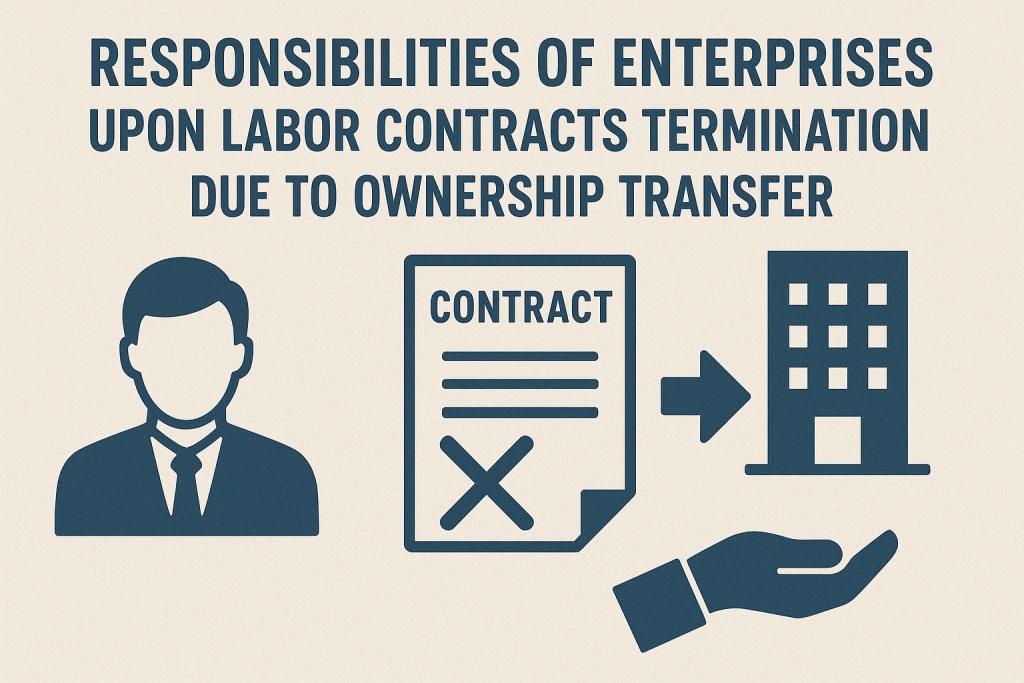
The termination of labor contracts due to ownership transfer presents a complex landscape for enterprises navigating the intricacies of labor law and employee rights. When a business changes ownership, the implications for existing labor contracts can be profound, affecting not only the continuity of employment but also the obligations of the new owners towards the workforce. This paper explores the responsibilities of enterprises in such scenarios, examining the legal frameworks governing labor contract termination, the rights of employees during ownership transitions, and best practices for ensuring compliance and minimizing disruption. Understanding these responsibilities is crucial for fostering a fair and transparent process that respects the interests of all stakeholders involved.
- Enterprise may proceed with labor contracts termination due to an ownership transfer, provided that it fully complies with the approved labor utilization plan
Pursuant to Article 43 of the Labor Code 2019:
“Article 43. Obligations of the employer in case of full division, partial division, consolidation, merger of the enterprise; sale, lease, conversion of the enterprise; transfer of the right to ownership or right to enjoyment of assets of the enterprise or cooperative
1. In case the full division, partial division, consolidation, merger of the enterprise; sale, lease, conversion of the enterprise; transfer of the right to ownership or right to enjoyment of assets of the enterprise or cooperative affects the employment of a large number of employees, the employer shall develop a labor utilization plan as prescribed in Article 44 of this Labor Code.
2. The current employer and the next employer shall implement the adopted labour utilization plan.”
As a matter of principle, upon the transfer of enterprise ownership, the transferee enterprise is obliged to inherit all rights and obligations, including the obligation to continue employing the existing workforce. Labor contracts termination shall only be permitted where no feasible employment arrangement can be made.
The enterprise is legally required to formulate a labor utilization plan, which must set out, inter alia, the number of employees to be retained and the number of employees whose labor contracts shall be terminated.
Such a labor utilization plan must be prepared in compliance with the statutory minimum requirements and duly adopted in accordance with the procedures prescribed by law. Specifically, the plan must include the following principal elements: (i) the number and list of employees who will continue to be employed, those who will undergo retraining for continued employment, and those who will be reassigned to part-time work; (ii) the number and list of employees who will retire; (iii) the number and list of employees subject to labor contracts termination; (iv) the rights and obligations of the employer, employees, and relevant parties in the implementation of the plan; and (v) the measures and financial resources ensuring the implementation of the plan.
During the formulation of the labor utilization plan, the enterprise is obliged to consult with the employees’ representative organization at the grassroots level (if any). Once approved, the plan must be publicly notified to the employees within 15 days.
The labor utilization plan serves as a crucial legal basis for determining the lawfulness of labor contracts termination and for clearly delineating the obligations of the enterprise vis-à-vis each individual employee concerned.
- Employees subject to labor contracts termination due to the transfer of enterprise ownership shall be entitled to severance allowance.
In cases where employees are dismissed under the approved labor utilization plan, those who have worked regularly for the enterprise for a period of at least 12 months shall be entitled to severance allowance. The entitlement is determined on the basis of the employee’s actual working period and salary, specifically:
(i) Working period for severance allowance calculation: equal to the total actual working period at the enterprise minus the period during which the employee has participated in unemployment insurance and the period already covered by severance allowance or redundancy allowance previously paid by the enterprise.
(ii) Salary basis for severance allowance calculation: for each year of service, the employee shall be paid one month’s salary, provided that the minimum payment is equal to two months’ salary. The salary serving as the basis for severance allowance is the average salary under the labor contract for the six consecutive months preceding the termination.
The enterprise is obliged to fulfill its severance allowance payment within 14 working days from the date of labor contracts termination.
In addition, the enterprise must comply with other statutory obligations such as confirming employees’ social insurance contributions, providing work history records upon request, and fulfilling other legal duties relating to employees’ rights.
- Obligation to delete employees’ personal data from January 1, 2026
Pursuant to the Law on Personal Data Protection 2025, upon labor contracts termination, enterprises must erase or destroy employees’ personal data previously collected and processed for recruitment and employment purposes.
Exemptions to this obligation shall only apply where otherwise agreed by the parties or where permitted by law.
In conclusion, the responsibilities of enterprises upon labor contract termination due to ownership transfer are multifaceted and critical to maintaining workforce stability. Employers must navigate complex legal obligations while ensuring that employees’ rights are upheld throughout the transition. By fostering open communication, providing adequate support, and adhering to labor laws, enterprises can mitigate the negative impacts of ownership changes on employees. Ultimately, a proactive approach to managing these responsibilities not only protects the interests of the workforce but also contributes to a smoother transition and long-term organizational success.
📞 CONTACT LEGAL CONSULTANT:
TLA Law is a leading law firm with a team of highly experienced lawyers specializing in criminal, civil, corporate, marriage and family law, and more. We are committed to providing comprehensive legal support and answering all your legal questions. If you have any further questions, please do not hesitate to contact us.
1. Lawyer Vu Thi Phuong Thanh, Manager of TLA Law LLC, Ha Noi Bar Association
Email: vtpthanh@tlalaw.vn
2. Lawyer Tran My Le, Chairman of the Members’ Council, Ha Noi Bar Association
Email: tmle@tlalaw.vn.
Dinh Phuong Thao

